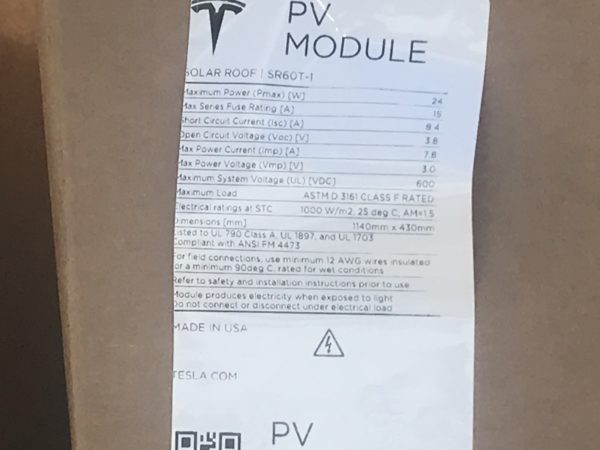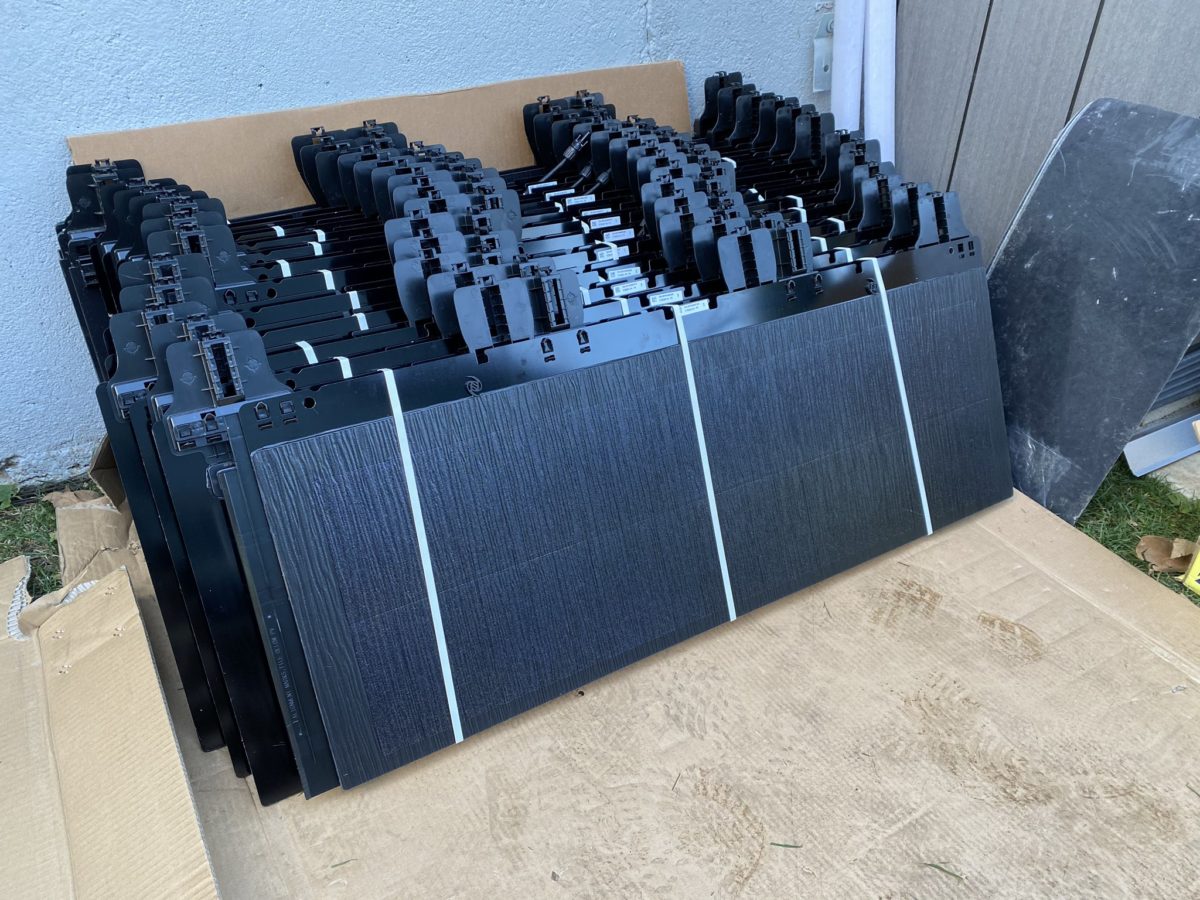While following the progress of Tesla solar roof installations in the San Francisco Bay Area, we discovered that some of the shingles were being made in China.
We also caught this product label which detailed the electrical specifications of Tesla solar roof tile model SR 60T-1, which provides enough detail to calculate the efficiency of the tile. (This product is labeled as made in the U.S.A.)

In order to figure out the efficiency of a solar module you have to do a little math. First, you multiply the length and width of the full solar modules including the non-power producing frame to get the area of the product. Second, you divide the module’s area by 1,000 since solar modules are rated based on standard test conditions of 1,000W/m2. Lastly, you divide the module’s rated wattage output (24 W in this case) by the module’s area which should provide the efficiency value.
In the case of the Tesla solar module specifications, we’re given dimensions of 1140mm x 430mm. Based upon these values on the label (which do not represent the exposed area of the final installed product), the efficiency of the product is 4.9%. The first modern solar cell invented in Bell Labs in 1954 had an efficiency of 4%.
Here is where we speculate a bit based upon limited data and attempt to apply some common sense. Feel free to check our math.
If we assume that the plastic pieces that protrude from the edges of the module are included in the sizing, then we can knock off roughly 10% of the width and 33% of the height – which results in an efficiency of 8.1%. Better, but still at the efficiency levels of the late 1950s.
Taking into account the overlap on how the tiles are installed on the roof — we can make another speculative size adjustment. All of the installations show that the solar modules overlay other modules to one side and below.
If we assume another 20% off of the height, and 10% off of the width — our efficiency hits 10%. Still a low value compared to the average residential solar module efficiency of around 18%.
However, reports have suggested that the solar tile installations meet 100% of the electricity usage of the customers — so, does efficiency actually matter?
It matters up to the point where it meets the needs of electricity users.
If Tesla’s solar roof is able to meet home power needs because customers are able to install the tiles on a larger proportion of the homeowner’s roof — then the importance of efficiency falls away compared to the effectiveness of the product.
Tesla roof installations that we’ve monitored are taking ten days to two weeks to complete. So, whether this product can be profitable for Tesla or roofers or provide a return-on-investment for homeowners is another story.
This content is protected by copyright and may not be reused. If you want to cooperate with us and would like to reuse some of our content, please contact: editors@pv-magazine.com.








Bottom Line, The customer is the final arbiter!
Interesting, you can not find information about the module efficiency in the Tesla web. During their presentation they didn’t make mention to the efficiency. This is because if you compare less of 10% to more of 17% in market Tesla could be in an embarrassing situation. At the end it is brand covering the reality.
For the space they take up and their poor efficiency, they must be amorphous. (shakes head). Not the most cost effective option for a solar installation.
Not amorphous. High-efficiency HIT technology, I believe.
“However, reports have suggested that the solar tile installations meet 100% of the electricity usage of the customers — so, does efficiency actually matter?”
There is a lot more going on here than one realizes. Just today long standing solar PV company Real Goods Solar or (RGS) filed for chapter 7 bankruptcy. Their roofing tile model based on the DOW solar roof tile the RPS 3.0 tile didn’t catch on and the board of directors decided on chapter 7 instead of 11,13.
This happens just after the NFPA announces their “rapid shutdown” requirement to solar PV panels. Reduction of voltage to 30VDC, 10 seconds after the inverter shuts down. So, when the 2020 NEC contains this requirement, what, 690.12, where will all of those yet to be installed TESLA tile roofs be as far as NEC compliance? So, one has the TESLA solar tile installed, the NEC changes requiring rapid shutdown per panel and then you’re suddenly not code compliant. Can you even turn your system on? Will the insurance company add your solar PV system to your home owners insurance policy? Right now there seems to be no devices or modules that connect to each solar tile or even solar PV panel that could curtail panel voltages to 30VDC much less in 10 seconds after the solar PV inverter shuts down.
With such a change in the NEC, what happens to solar PV systems with smart energy storage units? What if you have a “backup” circuit secondary C.B. panel that would fault over to off grid for some home circuits to stay powered by backup battery and an “off grid” inverter?
I find it interesting that the above SR 60T-1 spec. sheet is already rated at 30VDC, did TESLA have a heads up on the NEC change or is TESLA still under water when all of these ’tiles’ are snapped together on your roof?
Legitimate questions, but code changes usually take quite a while to be adopted by most jurisdictions and, even when they are, they generally have no application to buildings that have already been built and systems that have already been installed. Of course, a government could ban operation of systems considered unsafe, but that wouldn’t happen just by an NFPA regulation being adopted into the building code.
What are you talking about? I just read NFPA 70, 2020 draft and I don’t see any requirements that the current Solar Glass Roof wouldn’t meet.
I don’t find this estimate very surprising. I certainly expected lower efficiency from a tile designed for aesthetic purposes and durability Ryan from a panel designed for efficiency and cost.
But what the actual efficiency is does matter at least to the extent that the solar tiles cost more than the other tiles on a Tesla solar roof, so the lower the efficiency of the tiles is, the more the customer has to pay for a roof meeting all of the customer’s power needs.
If you could double the efficiency, you’d halve the portion of the roof tiles that needed to be covered with the more expensive type that generate power.
For example, using made-up numbers for easy math, a customer trying to choose between conventional solar panels with 20% efficiency and a solar roof using tiles with 10% efficiency should know that it will require twice as large of an areas with solar roof tiles to get the same power as with the more efficient panels. If the needed power is produced by standard panels on 1/4 of the roof or solar roof tikes on 1/2 of the roof and those solar tiles cost as much as all other roofing costs combined (labor, non-solar tiles, other materials, inverters, etc.), hypothetical tiles with 20% efficiency would reduce the total cost by almost 25%. A homeowner who thought that the same area of tikes would be needed as with conventional panels would be in for an unpleasant surprise.
I’m afraid you’re going to be very surprised at just how fast the NEC adopts NFPA-70E changes to the NEC code book. Pretty much happens on a three year cycle, 2017 definition of rapid shutdown already adopted. We are now in another three year cycle and Journeymen electricians will be required once again by many States of the Union to take at least a 20 hour course in NEC code changes and requirements to stay current in the workforce. I’d say this effectively puts an end to solar PV roof tiles by NFPA safety mandate.
It’s beautiful anyhow… better looking then most conventional tiles, so high tech.
Agreed, the efficiency only matters to the extent that it increases customer satisfaction, helping them save money and decrease their carbon emissions.
We have a steady stream of potential customers asking for the Tesla roof tiles and the primary barrier we would currently like to see them overcome is wind ratings. The tiles currently aren’t available to meet Miami code, 170 mph sustained wind. Until then, when we will be able to get some installations rolling, we have no way of determining whether they will be able to do a good job of meeting customer needs.
@Solarglassowner: Reading the “draft” and the final NEC determination may well be different and probably is. I have come across articles that have “defined” RSD 2020 to be at the (module) level, it sounds to me like there are two places the “array” needs to be “controlled”, at the panel level and at the string level. MY question is this 45 inch by 17 inch ’tile piece’ at 24 Watts STC, not PTC of about 21 Watts, has no RSD device at the ‘panel’ level. These modules seem to “snap” together to create a larger string with voltages up to 300 VDC? IF a fireman is on a fire during the day and hacks through the solar PV tile to gain entry into the roof attic for a vent and place to spray the fire from above, where on the array ‘string’ did the fireman just chop into? IS this particular installation positive lead on the top tiles and return on the bottom tiles that are snapped together?
On a roof mounted racked panel system, the fireman can pry loose one, two, three panels and chop through the roof right there. It is also the racked panel system that has the ability to have an RSD mounted to each panel in the array. If one has a micro-inverter or converter mounted under each panel, then RSD could be built into the device saving circuits, connections and space. Don’t see this type of detail on solar PV “roofing tiles”.
Bottom line, your ‘glass’ may not pass.
It should be noted that Tesla messed up the label for the new tiles. I have them and they are rated at 58.38 Watts. It might be useful to update this article with the corrected numbers.
following on NewSolar’s comments, i received delivery of solarglass tiles last week. the Pmax stamped on each module is 58.5W. i measured the area covered by the actual solar cells as 41.5″x12″. that works out to ~180W/m2 or ~18% efficiency.
A big Thank You for posting this update.
It’s wonderful at any rate… better looking than most ordinary tiles, so innovative.
Hi,
Just browsing this in the airport , and the recent comment by Tesla regarding the solar only being connected to the powerwall and this only to the utility/fuse box.
Is it possible that one of the reasons for the Tesla change of only installing powerwall with solar,is the proliferating standard for connecting solar to a utility?
I was unaware the panel standards kept changing….!
Rsg